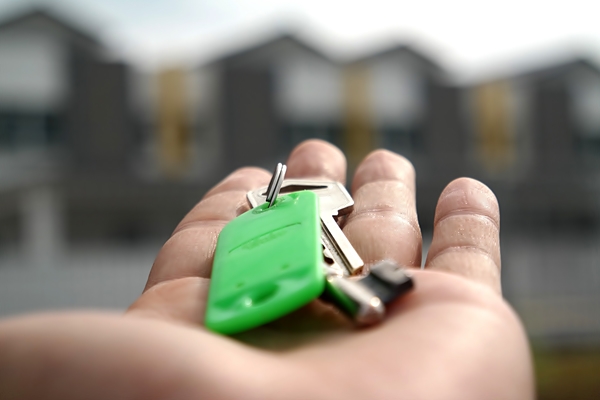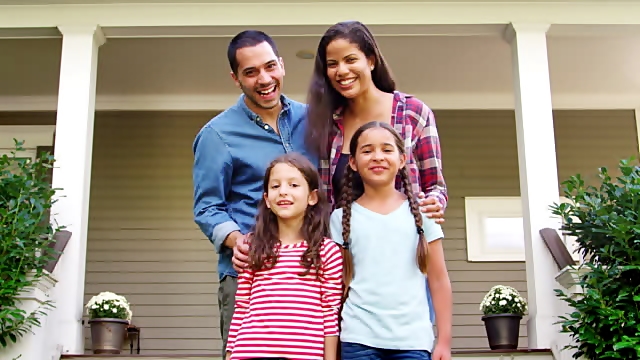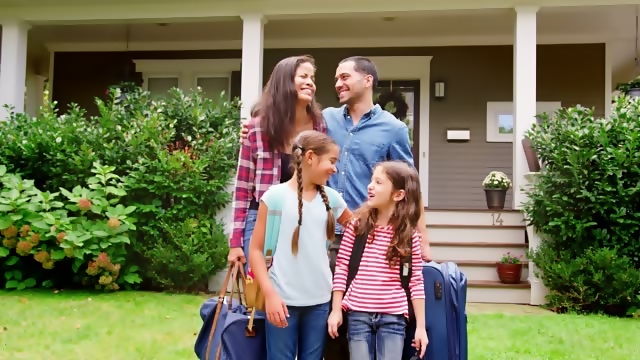What is a ‘Rent to Own’ program?
Homeownership is closer than you think!
How it Works
A ‘Rent to Own’ program, also known as a lease-to-own or rent-to-own agreement, is a housing arrangement that combines elements of renting and buying a home. In a rent-to-own program, the tenant has the opportunity to rent a property for a specified period, with the option to purchase the property at a later date.
The program typically works as follows:
Agreement: The tenant and the property owner enter into a legally binding agreement, outlining the terms and conditions of the rent-to-own arrangement. This agreement specifies the rental period, the purchase price of the property, and any additional terms or conditions.
Rent Payments: The tenant pays rent to the property owner, as in a traditional rental agreement. However, in a rent-to-own program, a portion of the rent may be set aside as a form of down payment or a rent credit that can be applied towards the purchase of the property.
Contact Us
Contact Us to own your own home.
Option Fee: The tenant may be required to pay an upfront option fee or option consideration, which grants them the exclusive right to purchase the property within a specified timeframe. This fee is typically non-refundable but is usually credited towards the purchase price if the tenant decides to buy the property.
Purchase Option: The rent-to-own agreement will include a purchase option, which outlines the predetermined purchase price of the property and the timeframe within which the tenant can exercise their option to buy. This provides the tenant with the opportunity to evaluate the property, build savings for a down payment, and improve their creditworthiness before committing to the purchase.
Purchase Decision: At the end of the rental period or within the specified timeframe, the tenant has the choice to exercise their option to buy the property or let it expire. If the tenant decides to proceed with the purchase, they can secure financing through a mortgage or other means to complete the transaction.
Rent-to-own programs can be beneficial for individuals who may not qualify for a mortgage immediately but still aspire to own a home. It allows them to rent a property while working towards homeownership, providing them with time to improve their financial situation and evaluate the property before making a long-term commitment.
A ‘Rent to Own’ program, also known as a lease-to-own or rent-to-own agreement, is a housing arrangement that allows tenants to rent a home while having the option to purchase it at a later date. It provides tenants with both the benefits of renting and the opportunity to potentially become homeowners.
In a rent-to-own program, the tenant enters into a lease agreement with the property owner, similar to a regular rental agreement. However, what sets it apart is the inclusion of an option to buy the property within a specified period, usually at a pre-determined price.
During the lease period, the tenant pays rent to the property owner as in a traditional rental agreement. However, in a rent-to-own program, a portion of the rent paid may be allocated towards a down payment or be considered as a rent credit that can be applied towards the future purchase of the property.
One significant advantage of a rent-to-own program is that it allows tenants to control the property they are renting. The property owner is bound by the agreement not to sell the home to anyone else during the lease period, giving the tenant the exclusive opportunity to purchase the property within the agreed timeframe.
The predetermined purchase price and the specific period within which the tenant can exercise their option to buy are outlined in the rent-to-own agreement. This gives the tenant time to assess the property, save for a down payment, improve their creditworthiness, and make an informed decision about homeownership.
It’s important to note that while rent-to-own programs can provide flexibility and potential homeownership opportunities, they also come with certain risks and considerations. It’s crucial for tenants to thoroughly understand the terms of the agreement, seek legal advice if needed, and carefully evaluate their financial readiness before entering into a rent-to-own program.
How is ‘renting’ a home different from ‘renting to own’ a home?

“Renting a home and renting to own a home differ in that renting to own involves the eventual purchase of the property. In a rent-to-own agreement, you sign an option to purchase agreement specifying your deposit and monthly ‘option premiums.’ These payments contribute toward your down payment when buying the home. From the day you move in, you have the freedom to decorate or upgrade the house. Additionally, your rent remains the same until you become the homeowner at the end of the term.”
Renting a home and renting to own a home are two different housing arrangements that offer distinct benefits and considerations. Here are the key differences between the two:
Ownership
Renting: When you rent a home, you are a tenant who pays rent to the landlord or property owner. You do not have any ownership rights or equity in the property.
Renting to Own: In a rent-to-own arrangement, you have the opportunity to become a homeowner. While you start as a tenant, you have an option to purchase the property within a specified timeframe. This provides the potential for ownership in the future.
Financial Commitment:
Renting: As a renter, you are not responsible for the long-term financial obligations associated with homeownership, such as property taxes, maintenance costs, or repairs.
Renting to Own: In a rent-to-own agreement, you may have additional financial responsibilities beyond rent. A portion of your rent payment might be allocated towards a down payment or serve as a rent credit that can be applied towards the purchase of the property.
Flexibility:
Renting: Renting offers greater flexibility since you can typically enter into a lease for a specific duration, such as a year, and have the option to move out at the end of the lease term without any further obligations.
Renting to Own: Rent-to-own arrangements may have more restrictions in terms of the duration of the lease and the option to purchase. The specific terms of the agreement will determine the timeframe within which you can exercise the option to buy.
Decision-making:
Renting: As a renter, you have limited control over the property. Major decisions about the property, such as renovations or selling the home, are made by the landlord or property owner.
Renting to Own: In a rent-to-own program, you may have more involvement in decision-making regarding the property since you have a vested interest in potentially becoming the owner.
It’s essential to thoroughly understand the terms and conditions of both renting and renting to own before making a decision. Each option has its own advantages and considerations, depending on your financial goals, timeline, and personal circumstances.
So, renting a home and renting to own a home have distinct differences in terms of the end goal and certain aspects of the arrangement. Here’s a revised version that aligns with the provided content guidelines:
“When you rent a home, your primary arrangement involves paying rent to the landlord without any future ownership rights. However, renting to own a home involves a different approach. In this case, you will have the opportunity to purchase the property at the end of the agreed-upon term.
To initiate a rent-to-own agreement, you will typically sign an option to purchase agreement. This agreement will outline the terms, including details about your deposit and monthly ‘option premiums.’ The deposit and option premiums you pay throughout the term will contribute towards your eventual down payment when you decide to buy the home.
One notable distinction is that from the day you move into the property, you are considered the ‘owner’ in terms of having the freedom to decorate or upgrade the house according to your preferences. Additionally, during the rent-to-own term, your rent amount usually remains consistent until you transition into homeownership at the end of the agreed-upon term.”

Who should enroll in a ‘Rent to Own’ program?
‘A ‘Rent to Own’ program can be beneficial for individuals who may not currently qualify for traditional mortgage financing but have the goal of becoming homeowners in the future. Here are some situations where enrolling in a rent-to-own program may be advantageous:
Limited Down Payment: If you have limited funds for a down payment, a rent-to-own program allows you to allocate a portion of your rent payments toward building up your down payment over time.
Credit Challenges: If you have a less-than-ideal credit history or a low credit score, a rent-to-own program provides an opportunity to improve your creditworthiness over the duration of the lease period. This can potentially enhance your chances of securing a mortgage when it’s time to purchase the property.
Time to Save: Rent-to-own programs offer tenants time to save additional funds for a down payment, closing costs, or other expenses associated with buying a home. This can be advantageous for individuals who need more time to gather the necessary financial resources.
Test the Property: If you’re unsure about a particular property or neighborhood, a rent-to-own arrangement allows you to live in the home before committing to the purchase. This gives you a chance to evaluate the property, the neighborhood, and determine if it meets your long-term needs and preferences.
Flexibility and Stability: Rent-to-own programs can provide stability and a sense of ownership even during the rental period. You have the opportunity to settle into a home, establish roots in the community, and experience the benefits of homeownership while still finalizing the purchase.
Self-Employment: Self-employed individuals may face challenges in meeting the strict income and documentation requirements of traditional mortgages. Rent-to-own programs offer an alternative path to homeownership for self-employed individuals who have difficulty meeting these requirements.
Inability to Refinance: Some individuals may already own a home but are unable to refinance due to various reasons, such as changes in financial circumstances or a decrease in property value. A rent-to-own program can provide an opportunity to secure a new home while working on resolving the issues preventing refinancing.
However, it’s important to note that rent-to-own programs may not be suitable for everyone. It’s advisable to thoroughly understand the terms of the agreement, seek legal advice if needed, and assess your financial readiness and long-term goals before enrolling in a rent-to-own program.
Evaluate your specific financial situation and goals before enrolling in a rent-to-own program. Understanding the terms and conditions of the program, seeking legal advice if needed, and carefully considering your long-term plans are crucial steps to ensure that a rent-to-own program aligns with your needs.
Ultimately, the decision to enroll in a rent-to-own program should be based on an individual’s specific financial situation, goals, and circumstances.
How does a Rent to Own program work?
The Rent to Own program begins with a pre-qualification interview, typically lasting 10-15 minutes. Upon successful completion, verification of employment, income, and down payment is required. Working with a real estate agent, the program helps find a suitable house within the program’s parameters and the client’s budget. Property analysis and comparisons determine the future purchase price based on average appreciation. An investor package is prepared and presented to potential investors for consideration. Once an appropriate investor is identified, an offer is submitted and, upon acceptance, the investor package is finalized. A lease agreement is then signed with the rent to own client for a predetermined term, allowing time to improve credit and accumulate at least a 10% down payment. Monthly payments consist of market rent plus an option premium, which contributes towards the down payment. Mortgage brokers periodically assess the client’s credit score to ensure improvement. At the end of the lease term, the client exercises the option to purchase the home, completing the journey to homeownership.

Are the monthly payments affordable?
The affordability of monthly payments in a Rent to Own program can vary depending on factors such as the local housing market, the specific terms of the agreement, and the individual’s financial situation. The goal of a Rent to Own program is to provide an opportunity for individuals to transition into homeownership, taking into consideration their current financial capabilities and the potential for improvement over the lease term.
In a Rent to Own program, the monthly payments typically consist of the market rent for the area plus an additional option premium that goes towards building the down payment. The total monthly payment will depend on factors such as the property’s rental market value, the agreed-upon option premium amount, and any additional fees or costs outlined in the program.
It’s important for individuals considering a Rent to Own program to carefully evaluate their personal financial situation, budget, and affordability before entering into the agreement. This includes considering their current income, expenses, and the potential for future financial growth or changes.
Ultimately, the affordability of monthly payments in a Rent to Own program should align with the individual’s financial capacity and ensure that they can comfortably meet the obligations of the program without undue financial strain.
It’s recommended to thoroughly review the terms of the specific Rent to Own program, including the breakdown of monthly payments and any associated costs, to determine the affordability in your particular situation.
Can families who have bad credit qualify?
While each Rent to Own program may have its own specific criteria and requirements, they generally consider factors beyond just credit score. These programs often take into account the individual’s overall financial situation, employment stability, income, and their commitment to improving their credit during the lease term.
Even if a family has bad credit, they may still be eligible for a Rent to Own program if they can demonstrate the ability to make regular monthly payments and show a genuine effort to improve their credit over time. The Rent to Own program allows families to work towards improving their credit during the lease period, giving them a chance to strengthen their financial standing and increase their chances of securing a mortgage when it’s time to purchase the home.
It’s important to note that the specific eligibility requirements may vary depending on the Rent to Own program and the participating parties involved. It’s recommended to inquire about the specific criteria of the program you are interested in to determine if families with bad credit can qualify.
Seeking the assistance of a reputable Rent to Own program provider or real estate professional can help families with bad credit navigate the process and explore available options to achieve their homeownership goals.
Reasons for Potential Decline in the Rent to Own Program
Most people are accepted into the program, but there are a few reasons for potential decline:
- Insufficient Initial Down Payment: Typically, 3-4% is required. (But it is at the discretion of the investor).
- Property Restrictions: Some houses may not meet the guidelines of investors or mortgage lenders. Factors such as rural areas, mobile homes, or cities/towns with a population less than 5,000 could lead to a decline.
- Low Income: Income below minimum requirement based on desired home value. Multiply income by 4 for affordability guide.
- Failure to Meet Required Deadlines: Timely submission of necessary documents and funds is crucial. We can only work with individuals who demonstrate 100% commitment to the program’s success. Meeting deadlines ensures that credit, employment, and down payment criteria are met.
- Insufficient Income: If an applicant’s income is not deemed sufficient to afford the monthly payments and meet other financial obligations, they may be declined.
- Unstable Employment: Lenders may consider employment stability as a factor in the approval process. If an applicant has an inconsistent work history or lacks stable employment, it could lead to a decline.
- Poor Rental History: A history of late rent payments, evictions, or other rental issues may raise concerns for program providers, potentially resulting in a decline.
- Inadequate Down Payment: If the applicant is unable to provide the required down payment or does not meet the minimum down payment criteria, it may lead to a decline.
- Unsatisfactory Credit: While Rent to Own programs are designed to help individuals with poor credit, certain programs may have specific credit requirements. If the applicant’s credit is extremely low or has recent bankruptcies or foreclosures, they may be declined.
- Inability to Meet Program Requirements: Each Rent to Own program may have its own set of requirements and criteria. If the applicant fails to meet the specific program requirements, such as credit repair obligations or maintaining the property, it could result in a decline.
- Legal or Background Issues: Serious legal or background issues, such as felony convictions or involvement in fraudulent activities, can be grounds for decline.
Addressing these factors ensures a successful Rent to Own program. Our commitment to your homeownership journey relies on your commitment to program requirements.
GET THE KEYS TO YOUR DREAM HOME IN 6 EASY STEPS
Are you ready to make your dream of owning a home a reality? Follow these 6 easy steps to get the keys to your dream home:
6 Steps to Your Dream Home
Step 1: Pre-Qualification Interview
Begin by scheduling a 10-15 minute pre-qualification interview. We’ll assess your eligibility for the program and gather essential information.
Step 2: Verification and Documentation
Once pre-qualified, provide the necessary verification of employment, income, and down payment. This ensures a smooth and efficient process.
Step 3: Home Selection with our Real Estate Agent & Review Your Quote
Work closely with our experienced real estate agent to find a house that aligns with our program and fits your budget. We’ll consider your preferences and financial goals. We will send you a quote based on the selected homes and your financial information. Take the time to review the quote, including the monthly payments. If you are satisfied with the terms, we’ll proceed to submit an offer on your behalf.
Any home that is listed on the MLS qualifies but it cannot:
- be zoned ‘commercial’
- have baseboard heating
- be a fixer upper
- be a mobile home
- have vermiculite

Step 4: Investor Approval and Offer Submission
Our team will analyze the chosen property, evaluating its market value and appreciation potential. We’ll prepare an investor package and submit a compelling offer on your behalf.
Step 5: Lease Agreement and Homeownership Journey
Once the offer is accepted, sign a lease agreement for a preset term. Make monthly payments that include the market rent for the area and an option premium, which contributes to your down payment. Throughout the lease term, we’ll monitor your progress and provide guidance to improve your credit score.
Step 6: Home Inspection and Approval
Once the seller approves the offer, it’s time to order a professional home inspection. This inspection covers the property from the basement to the attic, ensuring its condition aligns with your expectations.
By following these 6 steps, you’ll be on your way to homeownership. Say goodbye to renting and hello to the keys of your dream home.
Remember, the Rent to Own program offers a flexible and accessible path to homeownership, even for those with financial challenges. Take the first step today and unlock the doors to your dream home.
Frequently Asked Questions
Over the years, we’ve received various real estate-related questions. Here are some frequently asked question feel free to contact us for specific answers that apply to your situation.
-
-
- What’s the 1-year fixed mortgage rate?
- How about the 4-year fixed mortgage rate?
- What’s the 10-year fixed mortgage rate?
- Are there variable mortgage rates available?
- Where can I find the best credit union mortgage rates?
- How does the pre-approval process work?
- Can I get a mortgage with bad credit?
- Is it possible to obtain a mortgage after bankruptcy?
- What mortgage options are available for divorcing individuals?
- How does a home equity loan work?
- What’s involved in the rent-to-own process?
- How should I handle mortgage arrears?
- What role do mortgage agents play?
- What should first-time home buyers know?
- Can you explain the Vender Take Back mortgage?
- How does relocation impact the mortgage process?
- What considerations are there for buying a fixer-upper?
- Why is a house inspection important?
- What are the typical closing costs?
- What are the differences between residential and commercial mortgages?
- Can I receive cash back when getting a mortgage?
- What if I lack certain documents for my mortgage application?
- Can a mortgage be used for spousal buyouts?
- Are there specific mortgage options for second homes?
- How does the mortgage process work for construction projects?
- What’s the RRSP Home Buyers Plan?
- What’s the role of power of attorney in mortgages?
-
-
-
- What’s the current 2-year fixed mortgage rate?
- How about the 5-year fixed mortgage rate?
- What’s the 6-month closed mortgage rate?
- What’s the 1-year open mortgage rate?
- Where can I find the best bank mortgage rates?
- Where can I find the best private lender mortgage rates?
- What’s a home equity line of credit (HELOC)?
- Can I get a mortgage with new credit or no credit history?
- Is it possible to consolidate debts with a mortgage?
- What mortgage options are there for separated individuals?
- Can a mortgage be used for renovations?
- How does the lease-to-own process work?
- What should I do if I have income tax arrears?
- What’s the role of mortgage brokers?
- How much down payment is required for a mortgage?
- What’s seller financing and how does it work?
- Where can I find houses for sale?
- What’s involved in selling a house by owner?
- Why is a house appraisal necessary?
- What should I know about estate sales?
- What considerations are there for real estate investments?
- Can I get a mortgage if I’m self-employed or own a business?
- What mortgage options are there for newcomers to Canada?
- Can I get a mortgage for a mobile home?
- What if my bank declines my mortgage application?
- What should I know about zoning issues?
- Are there considerations for properties on leased land?
- Can a mortgage be used for purchase + improvements?
-
-
-
- What’s the current 3-year fixed mortgage rate?
- How about the 7-year fixed mortgage rate?
- What’s the 6-month open mortgage rate?
- Where can I find the best bank mortgage rates?
- Where can I find the best private lender mortgage rates?
- What’s an unsecured line of credit?
- Can I get a mortgage as a new Canadian resident?
- Can I get a mortgage after a consumer proposal?
- How can I remove a name from a mortgage?
- What’s a reverse mortgage?
- Mortgage Penalty
- What are the penalties for breaking a mortgage?
- How do tax sales impact mortgages?
- How do I choose the right mortgage lender?
- Where can I find houses for sale?
- What’s the current real estate market like?
- What should I know about private sales?
- When do I need a real estate lawyer?
- What should I consider when buying a vacant home?
- Are there mortgage options for low-income individuals?
- What should I know about renting or buying a condo?
- Are there mortgage options for private financing?
- Are there special considerations for First Nations individuals?
- Can a mortgage be used to pay tax arrears?
For personalized assistance and guidance, please contact us directly.
-








